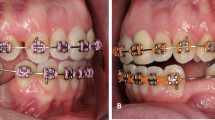Abstract
This review article describes the basics and clinical applications of skeletal anchorage in orthodontics, namely: areas of indication, anchorage devices, insertion areas, indications, potential complications, and their use in growing patients.
The areas for skeletal anchorage include orthodontic-prosthetic anchorage, orthodontic anchorage, and skeletal anchorage in orthopedic therapy procedures. The anchorage devices currently available are: prosthetic implants, mini screws, palatal implants, onplants, bone anchors, zygoma wires and skeletally-supported distractors. The insertion areas described so far (according to therapeutic procedure and bone supply available) include edentulous jaw sections, the interdental septum, infra-apical and supra-apical areas, the palate (median, paramedian, lateral), the retromolar area, and the zygomatic bone. Force systems are applied (direct or indirect anchorage) according to surgical and orthodontic or orthopedic requirements. Skeletal anchorage devices should be selected according to the following criteria. Is the anchorage task unifunctional or multifunctional? How many anchorage devices are required for the therapy in question? What is the success rate of the various anchorage devices; what are the applicable biomechanics and soft tissue or hard tissue conditions in the insertion area? The success rates for miniscrews are currently between 80% and 90%, and over 90% for palatal implants.
The potential of skeletal anchorage is broadening the current orthodontic treatment spectrum, guaranteeing the practitioner absolute control of anchorage by avoiding the unpredictable reactions of periodontal anchorage, leading to a reduction in unwanted side effects.
Zusammenfassung
Der vorliegende Artikel beschreibt die Grundlagen und die klinische Anwendung der skelettalen Verankerung in der Kieferorthopädie: Indikationsbereiche, Verankerungsmittel, Insertionsbereiche, Indikationen, potentielle Komplikationen und die Nutzung beim noch wachsenden Patienten.
Als Indikationsbereiche der skelettalen Verankerung sind heute zu nennen: orthodontisch-prothetische Verankerung, orthodontische Verankerung und skelettale Verankerung bei kieferorthopädischen Behandlungsaufgaben. Als Verankerungsmittel stehen heute zur Verfügung: prothetische Implantate, Minischrauben, Gaumenimplantate, Onplants, Bone Anchors, Zygoma-Drähte und skelettal abgestützte Distraktoren. Je nach Behandlungsaufgabe und dem Knochenangebot wurden folgende Insertionsbereiche beschrieben: zahnloser Kieferabschnitt, interdentales Septum, infraund supraapikaler Bereich, Gaumen (median, paramedian, lateral), retromolarer Bereich sowie der Bereich des Os zygomaticum. Die Applikation des Kraftsystems (direkte/indirekte Verankerung) richtet sich nach den chirurgischen und orthodontischen/orthopädischen Erfordernissen. Die Selektion des skelettalen Verankerungsmittels sollte nach folgenden Kriterien erfolgen: uni- bzw. multifunktionelle Verankerungsaufgaben, Anzahl der notwendigen Verankerungselemente für die jeweilige Behandlungsaufgabe, Erfolgsrate der diversen Verankerungselemente, der zu applizierenden Biomechanik und der Weichgewebe- sowie Hartgewebebedingungen im Insertionsbereich. Die Erfolgsraten liegen heute bei Minischrauben bei 80–90%, bei Gaumenimplantaten bei über 90%.
Die heutigen Möglichkeiten der skelettalen Verankerung erweitern das kieferorthopädische Behandlungsspektrum, garantieren eine absolute Kontrolle der Verankerung durch den Behandler, umgehen die unvorhersagbaren Reaktionen der desmodontalen Verankerung und führen zu einer Reduktion unerwünschter Nebenwirkungen.
Similar content being viewed by others
Author information
Authors and Affiliations
Corresponding author
Rights and permissions
About this article
Cite this article
Wehrbein, H., Göllner, P. Skeletal Anchorage in Orthodontics – Basics and Clinical Application. J Orofac Orthop 68, 443–461 (2007). https://doi.org/10.1007/s00056-007-0725-y
Received:
Accepted:
Issue Date:
DOI: https://doi.org/10.1007/s00056-007-0725-y
Key Words:
- Skeletal anchorage
- Miniscrews
- Palatal implants
- Bone anchors
- Bone-supported RME
- Skeletal maxillofacial protraction




